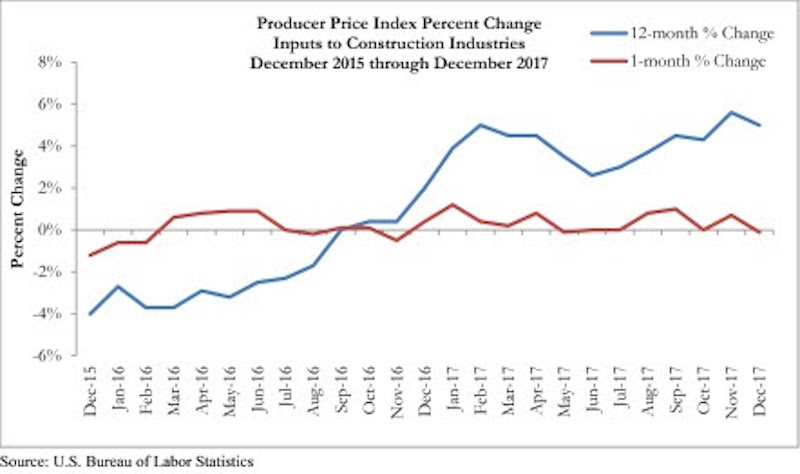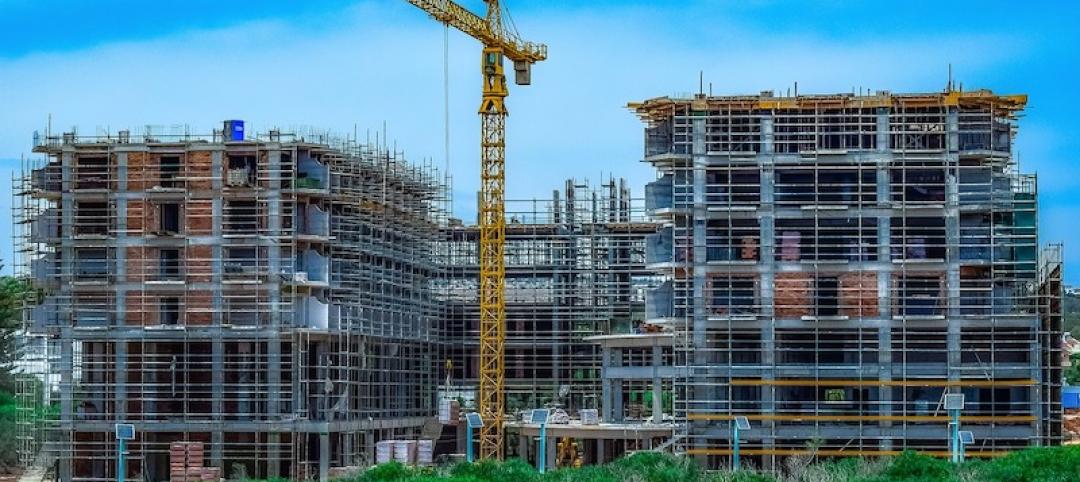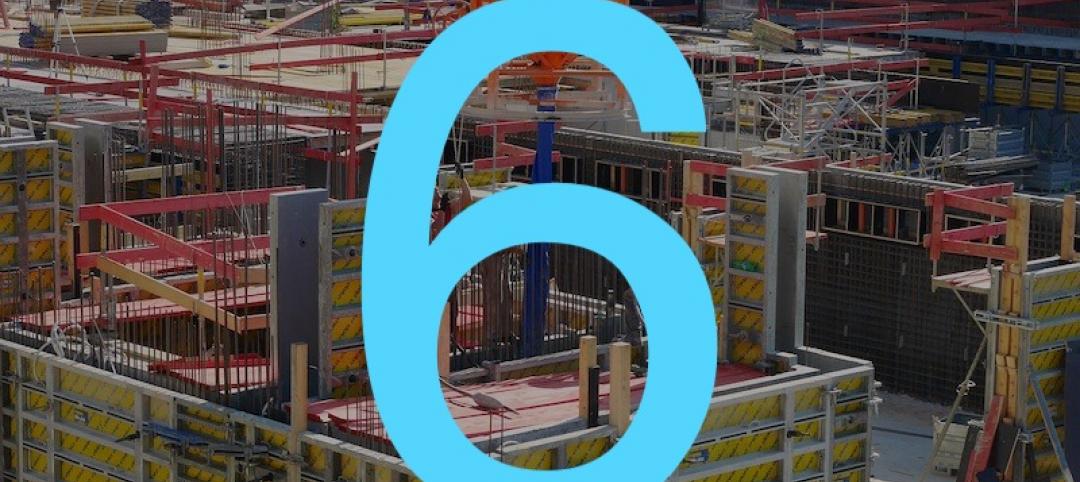Overall construction input prices declined 0.1% in December, yet despite the lack of inflation for the month, prices are up 5% on a year-over-year basis, according to an Associated Builders and Contractors (ABC) analysis of Bureau of Labor Statistics data released today. Nonresidential construction materials prices also declined 0.1% for the month and are up 4.8% from the same time one year ago.
Energy prices have been more volatile lately. Natural gas prices increased 13.7% from November, but are 6.3% lower on a year-over-year basis. Crude petroleum prices rose 16.4% between December 2016 and December 2017 and have been climbing higher during the first days of 2018.
“Given stronger global and domestic economic growth, elevated liquidity in international financial markets, burgeoning trade disputes and efforts by certain energy producers to limit supply growth even as prices rise, one would have expected a sharper increase in construction materials prices in December,” said ABC Chief Economist Anirban Basu. “The fact that inflation remains contained should be viewed by most contractors as very good news. Not only are many contractors vulnerable to sudden increases in certain materials prices, but faster inflation can trigger higher interest rates, which ultimately reduce the demand for construction services.
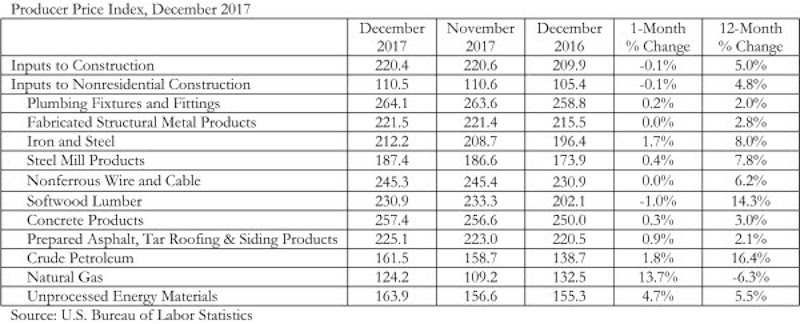
“Though the overall Producer Price Index (PPI) indicates low December inflation, a number of materials prices increased, including iron and steel and the category that includes prepared asphalt,” said Basu. “Softwood lumber prices, by contrast, fell.
“Despite December’s reprieve from rising inflationary pressures, many economists expect inflation to become more apparent as 2018 proceeds,” said Basu. “Recently enacted federal tax cuts stand to supercharge the economy, which should translate into more construction starts later this year and into 2019. At the same time, growth in Europe and in much of Asia remains solid. India’s economy is expected to expand more than 7% this year, and China’s by more than 6%. The upshot is that December’s data may come to represent an exception during an increasingly inflationary period.”
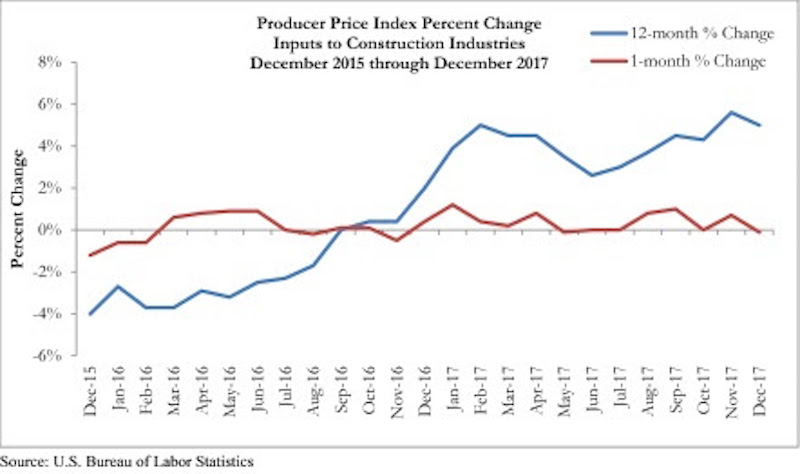
Related Stories
Market Data | Oct 16, 2020
5 must reads for the AEC industry today: October 16, 2020
Princeton's new museum and Miami's yacht-inspired luxury condos.
Market Data | Oct 15, 2020
6 must reads for the AEC industry today: October 15, 2020
Chicago's Bank of America Tower opens and altering facilities for a post-COVID-19 world.
Market Data | Oct 14, 2020
6 must reads for the AEC industry today: October 14, 2020
Thailand's new Elephant Museum and the Art Gallery of New South Wales receives an expansion.
Market Data | Oct 13, 2020
5 must reads for the AEC industry today: October 13, 2020
Miami Beach Convention Center renovation completes and guidance offered for K-12 schools to support students with asthma.
Market Data | Oct 12, 2020
Majority of contractors fear long-term business implications of COVID-19, according to Construction Executive survey
While many contractors have not yet seen drastic impacts to their business, as construction was in many areas considered an “essential” service, the long-term implications are concerning.
Market Data | Oct 12, 2020
6 must reads for the AEC industry today: October 12, 2020
4 challenges of realizing BIM's value for an owner and Florida office property is designed for a post-Covid world.
Market Data | Oct 8, 2020
6 must reads for the AEC industry today: October 8, 2020
The first rendering of the National Medal of Honor Museum is unveiled and seven urgent changes needed to fix senior living.
Market Data | Oct 7, 2020
6 must reads for the AEC industry today: October 7, 2020
Water-filled windows' effect on energy and construction begins on PGA of America HQ.
Market Data | Oct 6, 2020
Construction sector adds 26,000 workers in September but nonresidential jobs stall
Many commercial firms experience project cancellations.
Market Data | Oct 6, 2020
6 must reads for the AEC industry today: October 6, 2020
Construction rises 1.4% in August while nonresidential construction spending falls slightly.


